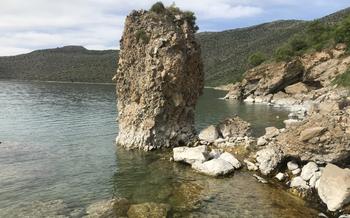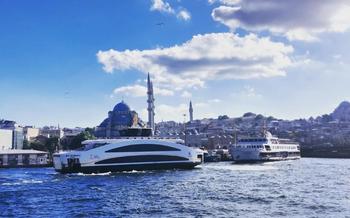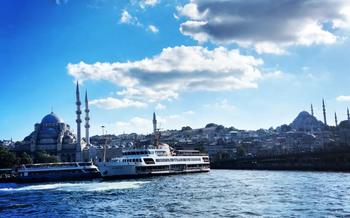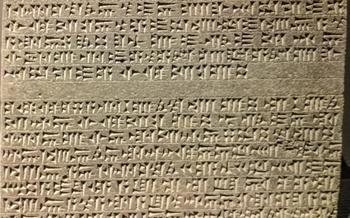
Külahlı Church
- Historical Significance
- Architectural Marvel
- Preservation and Restoration
- Historical Context
- Cultural Significance
- Tourism and Accessibility
- Visitor Etiquette
- Local Accommodation
- Transportation
- Safety and Security
- Language and Communication
- Budgeting and Costs
- Insider Tip: Unveiling Van's Hidden Treasures
Historical Significance
The Külahlı Church, nestled amidst the ancient ruins of Van, holds a profound historical significance that draws visitors from far and wide. Built in the 10th century, during the reign of the Armenian Bagratid dynasty, it stands as a testament to the region's rich cultural and religious heritage. The church's dedication to the Virgin Mary, known locally as the Holy Mother of God, reflects the deep devotion of the Armenian community to their faith. Its enduring presence through centuries of political and religious upheavals speaks volumes about the resilience and perseverance of the Armenian people.
Beyond its religious significance, the Külahlı Church showcases exceptional architectural features that blend Byzantine and Armenian influences. Its unique conical dome, intricate carvings, and stunning frescoes depict biblical scenes and historical events, offering visitors a glimpse into the artistic and cultural expressions of the time. The church's exceptional preservation over the centuries is a testament to the craftsmanship and dedication of its builders, who ensured its longevity despite the passage of time and the challenges of a turbulent region.
Architectural Marvel
The Külahlı Church stands as a testament to the architectural prowess of its builders. Its exterior facade boasts intricate carvings and decorative elements that reflect the blending of Byzantine and Armenian influences. The church's dome, a remarkable feat of engineering, is a prominent feature that dominates the skyline. Its construction showcases innovative techniques that have allowed it to withstand the test of time.
Inside, the church's interior is adorned with stunning frescoes, mosaics, and carvings that depict religious scenes and figures. These intricate artworks bring to life the stories and teachings of Christianity, offering visitors a glimpse into the rich spiritual heritage of the region. The church's floor plan, with its central nave and side aisles, is a classic example of Byzantine architecture, while the Armenian influence is evident in the use of pointed arches and vaulted ceilings.
The Külahlı Church's architectural significance extends beyond its religious function. It serves as a valuable example of the architectural styles that flourished in the region during the Middle Ages. Its unique blend of Byzantine and Armenian elements makes it a standout among other churches in the area, attracting visitors and scholars alike who marvel at its beauty and historical significance.
Preservation and Restoration
Despite its resilience and longevity, the Külahlı Church has faced challenges over time, including natural disasters and neglect. Recognizing its cultural and historical significance, significant efforts have been made to preserve and restore this architectural masterpiece. Local authorities, in collaboration with international organizations and experts, have played a crucial role in safeguarding the church's structural integrity and preserving its unique features.
One of the most notable restoration projects was undertaken in the late 19th century, when the church's dome was reinforced and repaired to prevent further deterioration. In the 20th century, extensive restoration work was carried out, focusing on the church's exterior and interior. This included cleaning and repairing the stonework, restoring the frescoes and mosaics, and stabilizing the structure to ensure its longevity.
Preserving the Külahlı Church is not only about maintaining a physical structure but also about protecting its cultural and historical significance. It serves as a tangible reminder of the region's rich heritage, fostering a sense of identity and continuity among the local community. Ongoing efforts to preserve and restore this architectural gem ensure that it remains a symbol of resilience and cultural pride for generations to come.
Historical Context
The Külahlı Church, nestled within the ancient city of Van, holds a rich tapestry of history intricately woven into its very fabric. Erected during the 10th century under the patronage of the Armenian Bagratid Dynasty, the church stands as a testament to the region's complex political and religious landscape. Built during a period of relative peace and prosperity, the church reflects the cultural and architectural zenith of the Bagratid era.
The 10th century marked a significant chapter in Van's history. The city served as the capital of the Armenian Kingdom of Vaspurakan, a powerful and influential state in the region. The construction of the Külahlı Church coincided with the reign of King Gagik I Artsruni, a figure renowned for his patronage of the arts and architecture. Under his rule, Van flourished as a center of learning and culture, and the church's construction exemplified this golden age.
The church's strategic location within the city's fortifications further underscores its historical significance. Situated atop a hill overlooking Van, the church served not only as a spiritual sanctuary but also as a defensive structure. Its commanding position provided a vantage point for monitoring the surrounding landscape, enhancing the city's defensive capabilities.
Throughout the centuries, the Külahlı Church has witnessed numerous historical events, serving as a silent observer to the rise and fall of empires. It has endured invasions, earthquakes, and the changing tides of political power, emerging as a symbol of resilience and continuity. Today, the church stands as a testament to the rich cultural heritage of the Van region, a legacy that continues to inspire and captivate visitors from around the world.
Cultural Significance
The Külahlı Church holds immense cultural significance to the local community of Van. It serves as a tangible link to the region's rich history and cultural heritage. The church has played a pivotal role in shaping the identity and heritage of the people of Van, embodying their resilience and unity amidst the many challenges they have faced throughout history.
Over the centuries, the church has become a symbol of hope and perseverance for the local community. It has witnessed countless events, celebrations, and moments of reflection, becoming an integral part of the cultural fabric of Van. The church's enduring presence has fostered a sense of community and belonging among the people, who take pride in its preservation and continued significance.
Today, the Külahlı Church stands as a testament to the enduring spirit of the people of Van. It is a place of worship, a source of inspiration, and a reminder of the rich cultural heritage that binds the community together. Visitors to the church can immerse themselves in its history, appreciate its architectural beauty, and experience firsthand the deep cultural significance it holds for the local people.
Tourism and Accessibility
Visiting the Külahlı Church is a rewarding experience that offers a glimpse into the region's rich history and culture. The church is open to the public daily, with extended hours during the summer months. Visitors are welcome to explore the church's interior and admire its stunning architecture and frescoes. Guided tours are available for those who want to learn more about the church's history and significance.
The best time to visit the Külahlı Church is during the spring or fall when the weather is mild and pleasant. During the summer months, temperatures can soar, making it uncomfortable to explore the church's interior. Winter can be harsh in Van, with heavy snowfall and icy conditions, so it's advisable to check the weather forecast before planning a visit during this time.
The church is wheelchair accessible, with ramps and elevators available to assist visitors with disabilities. Visitors can also take advantage of the audio guides provided at the entrance, which offer detailed information about the church's history and architecture.
After visiting the Külahlı Church, visitors can explore the nearby Van Castle, which offers panoramic views of the city and Lake Van. Other attractions in the area include the Van Museum, which houses a collection of artifacts from the region's past, and the Van Cat House, where visitors can interact with the unique Van cats, known for their distinctive eye colors.
Visitor Etiquette
When visiting the Külahlı Church, it is crucial to be mindful of its religious and cultural significance. As a place of worship for the local Christian community, visitors should maintain a respectful demeanor and adhere to appropriate dress code. Modest attire that covers shoulders and knees is recommended. While taking photos is permitted, it is important to be discreet and avoid using flash photography, especially during religious services. Visitors should also be mindful of noise levels and refrain from engaging in loud conversations or disruptive behavior. By respecting the sanctity of the church and the privacy of other visitors, you can contribute to preserving its sacred atmosphere.
Local Accommodation
Van offers a range of accommodation options to suit every budget and preference. For a comfortable and convenient stay, consider the Van Oteli, located just a short walk from the Külahlı Church. This modern hotel offers spacious rooms with stunning views of the city. For a more affordable option, the Van Hostel provides clean and comfortable dormitory-style accommodation in the heart of the city center.
If you're looking for a unique and authentic experience, opt for a stay at one of Van's traditional guesthouses. These charming guesthouses often offer a glimpse into local life and culture. The Van Konagi is a popular choice, with its cozy rooms decorated in traditional Turkish style and a warm and welcoming atmosphere.
No matter your budget or preferences, you'll find a range of suitable accommodation options in Van. Embrace the local hospitality and enjoy a comfortable and memorable stay in this vibrant city.
Transportation
Getting to Van and the Külahlı Church is relatively straightforward, with several transportation options available. The city is well-connected by air, with Van Ferit Melen Airport (VAN) offering direct flights from major cities in Turkey, including Istanbul, Ankara, and Izmir. Several airlines operate these routes, providing competitive fares and convenient flight schedules.
Once in Van, visitors can easily reach the Külahlı Church using public transportation. The city's bus network is efficient and affordable, with buses departing from various points in the city center to the church's vicinity. Alternatively, visitors can opt for the convenience of taxis, which are readily available and offer a comfortable and direct journey to the church.
For those who prefer a more immersive experience, renting a car is an excellent option. Van offers several car rental agencies, allowing visitors to explore the city and its surroundings at their own pace. The roads in Van are generally well-maintained, and driving is a safe and enjoyable experience. However, it's essential to be aware of local traffic regulations and customs to ensure a smooth and hassle-free driving experience.
Organized tours are another popular option for visitors who want a comprehensive and guided experience. Several tour operators in Van offer day trips or multi-day excursions that include a visit to the Külahlı Church, along with other historical and cultural attractions in the region. These tours often provide transportation, a knowledgeable guide, and insights into the history and significance of the sites visited.
Safety and Security
Van is generally considered a safe city for travelers, with a low crime rate and a welcoming population. However, as with any destination, it's essential to take basic safety precautions to ensure a hassle-free trip. Be aware of your surroundings, especially in crowded areas, and avoid walking alone at night. Keep your valuables secure and don't flash large amounts of cash. Scams targeting tourists are rare but can occur, so be wary of unsolicited offers or requests for money. If you encounter any problems or feel unsafe, don't hesitate to contact the local authorities or seek assistance from your hotel or tour operator.
Language and Communication
The primary language spoken in Van is Turkish, and the level of English proficiency among locals varies. To effectively communicate with locals who may not speak English, it's helpful to learn a few basic Turkish phrases or use translation apps like Google Translate. It's also important to be respectful of local customs and traditions, such as greeting people with a handshake or nod, and avoiding sensitive topics like politics or religion. To enhance your communication skills, consider using language learning resources or apps before your trip. This will allow you to connect with locals on a deeper level and gain a richer understanding of the local culture.
Budgeting and Costs
Visiting the Külahlı Church and exploring Van can be a budget-friendly experience. The cost of transportation, accommodation, food, and activities is generally affordable compared to other popular tourist destinations in Turkey. Here are some tips for saving money:
- Opt for public transportation or shared taxis to get around the city. Rental cars are also available but can be more expensive.
- Choose budget-friendly accommodation options such as hostels, guesthouses, or small family-run hotels.
- Sample local cuisine at traditional Turkish restaurants or cafes. Street food vendors also offer delicious and affordable options.
- Take advantage of free walking tours or guided tours with local guides to explore the city's highlights.
- Visit the church during off-peak seasons to avoid crowds and potentially lower prices for accommodation and tours.
Remember that prices can vary depending on the time of year, demand, and your personal preferences. It's always a good idea to research and compare prices before making reservations or purchases.
Insider Tip: Unveiling Van's Hidden Treasures
As you delve into the captivating history of Van, don't miss the opportunity to uncover its hidden gems. Beyond the Külahlı Church, the city boasts a wealth of unexplored wonders waiting to be discovered. Embark on a culinary adventure at the local markets, where you can savor the region's delectable street food and indulge in the aromatic delights of freshly brewed Turkish coffee. Immerse yourself in the vibrant energy of the city's bazaars, where you can haggle for unique souvenirs and handmade crafts. Discover the serene beauty of Lake Van, Turkey's largest lake, and embark on a scenic boat tour to explore its picturesque islands and hidden coves. Van is a city that rewards the curious traveler, so step off the beaten path and embrace the unexpected treasures that await you.









